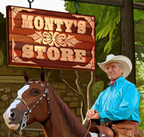Hi all,
I was wondering how you would go about training a horse to rear deliberately. And how you would prevent it from getting out of hand?
It certainly looks very impressive but I wouldn't want to try and then it get out of hand and my horse start rearing of his own accord?
I'm not actually thinking of doing this just now but just as a general query :)
Thanks,
Abi




Hi. Why would you want to teach your horse to perform an act that is muscularly detrimentally? In the wild they would do this only in a situation where nothing else will work. If you demand this regularly your horse wil be compromised,physically. Why would you want to do that? Or did you not realise that was a conseqy. Cheers, Jo.
Hi Jo,
I didn't realise that there would be other consequences, could you explain further?
It's just in Kelly Mark's book (perfect partners) there is a case study about someone who taught their horse to rear by clicker. It doesn't say anything about there being any physical damage or excess muscular strain in the study or in Kelly Mark's response. The case study focuses on how the trainer confused the horse and then corrected her own mistake. I would be very interested to hear if there are any negative effects of training to rear on command :)
Thanks,
Abi
Hi. Excessive use of back legs in the upright changes the muscles, shortens the stride & causes back strain. Don't panic if your horse does this in exuberance. Just don't encourage it. In the wild horses kill with the front legs, pounding down on enemies. It's an extreme reaction & in a domestic situation, where you want a partnership, it should be avoided, if for no other reason than it is very dangerous as the horse is very vulnerable to falling over, injuring itself (vets bills), injuring the rider (pain) & damaging your saddle (more expense). In Britain we often ride on roads - very hard surface & a bit slippery in many situations when wearing metal shoes. Horses that rear when ridden are dangerous but Monty has a brilliant, violence free cure - get Monty's book 'From My Hands To Yours'. Cheers, Jo.
I see, thankyou, very helpful, and I will :)
Abi
Hi,
I have to respectfully disagree with Joe on this. Rearing has been part of Haute École dressage for a very long time and rearing is even discussed by Xenophon (427-355 BC) the first known horse whisperer. Look at Lippizzaners and Andalusian horses in Haute École shows and you'll perfectly well balanced and muscled horses.
The part where I totally agree on is that this should never be thought to any untrained horse or by someone who has not the necessary knowledge to do so. Haute École horses have gone through intensive dressage training before learning any "airs above the ground," including the courbette, capriole, levade, and ballotade.
Pierre
Hi. Pierre, You are right, there are disciplines where rearing is included. However, 'airs above the ground' are not traits desirable in a horse used for anything else! I maintain horses that rear up are a danger to themselves & their humans. There are cultures where horses fight each other, as sport. Other cultures encourage bull fighting & horses are involved in that. Despite being given armour these horses suffer horrid injuries. Because it happens does not make it right. Monty has highlighted some very undesirable practices used in dressage training. Cheers, Jo.
I would like to address one of Abi's actual questions; how to prevent it from getting out of hand.
.
Speaking from experience, I would say; you can't!
There is simply too much to factor in to cover all bases.
.
I have been around a couple of horses that were taught (not by me!) to rear up and while they never did that in agression, they still caused accidents because there were times when they mistook/misunderstood signals, or were handled by people who had no idea they gave that signal.
.
One pony even learned to use it as a way to get out of doing other things. He didn't try to hurt anyone, but if he didn't understand, or felt something was too tiresome to do, he would chance on the rearing up instead, because that trick had earned him both praise and rest before. Usually worked like a charm too, since he unwittingly scared whoever handled him into leaving him alone. :D
My mustang stallion started rearing when he would see me coming to feed., I encouraged it, and soon he started doing it on command. One time he was a bit too close, (to his way of thinking) and he refused to rear with me that close again. He never reared when I rode him or when I was working with him, so I thought, and still do, there wasn't a thing wrong with it.
I also taught my wild mustang to rear on command, in saddle and have been using it to entertain kids and adults alike for the past five years and have never had him to rear without my request which is very specific. He also dances and spins on request and I even entered him in a jumping show just for fun and he won his division.. I never use force in working with him and have had no issues, plus he seems to enjoy showing off and the attention he gets from it.
Nice to see so many different points of view.
Parts of comments that caught my attention:
muscled horse - the horse must be fit before any training in this area, the same with piaffe and other dressage moves.
someone who has not the necessary knowledge - essential to really know what you're doing, training essential.
mistook/misunderstood signals - Goes along with training so clear signals are given every time a request for rear.
.
Something I found when working with horses that were rearing out of control due to fear or they've gotten into a habit of rearing especially with new situations, was to become passive before them, head down to the ground so no eye contact and slightly bend your shoulder at the same time. With or without the dually, this passive action took pressure away from them and they were able to learn from the situation and the rearing came under control.
Hope it helps if teaching your horse to rear.
x
Hi, can I just revisit Monty's view on this. Horses that spend a lot of time up on their back legs change their muscle structure in the back end & that compromises their back end movement, shortening the rear leg stride. Teaching a horse to stand on its back legs is mostly undesirable for many reasons, not least that, even though you may know what you're doing someone else could find themselves in a life threatening situation - the horse would be blamed! We love our horses & should teach them skills that will give them continuous kind, fair & safe handling throughout their lives. Cheers, Jo.
Hi all, I just thought I would clear up some confusion on the matter of rearing vs High School movements in Classical Equestrianism, an area which I have experience in and am continually researching.
There is a HUGE difference between a rear and the high school movement known as the 'levade' and neither are suitable for amateurs to experiment with teaching their horses. I don't mean to sound harsh but this is important in terms of both safety and the maintainance of a happy horse psychologically and physically. It is very easy to do serious damage where shortcuts are taken.
The levade is a very controlled and highly schooled movement that has a very specific angle - 30 degrees at the hock to be precise. It is meant to represent the height of collection in that the horse is able to collect and lower the hindquarters whilst simultaneously raising the forehand to the degree that he can physically lift himself off the floor. It is the precursor to the airs above the ground such as capriole, courbette, etc which are practised by some classical trainers and is the result of a long period of gradual training. It is preceded by the training of the reinback and the 'school halt'. It is physically very difficult for a horse that is not correctly muscled and schooled to sustain an action such as the levade for a period of time.
This is very different from a horse trained to rear on command. Many trick or film trainers will train a horse to do this but these are highly experienced professionals who do everything to ensure their horses are not compromised physically or mentally in doing so.
Horses rearing in the field and posturing or striking at each other (as is often seen between young colts, or stallions in the wild) will often lift themselves much higher or twist/leap but we must remember the risks associated with this level of athleticism and not ask our horses to repeat this out of context which could cause strain etc. There are many fine lines in Equus between exuberance, posturing, challenging and actual fight, to name a few. Classical equestrianism seeks to remove the adrenaline and emotion in order to produce a controlled movement which will serve to build-up, not break-down, the horse in doing so.
Hope that helps!
Very interesting Tessa thank you; nice to see you commenting on posts, always good to have input from Instructors.
Yeah. Really good to have a certified instructor's view. Any horse trained to those levels is highly unlikely to find itself on the open market on sale as a hack/pleasure horse. But then Formula 1 cars don't get sold to the general public either! Suffice to say, teaching your horse to rear is not a good idea, except in extraordinary circumstances as outlined by Tessa. Cheers, Jo.